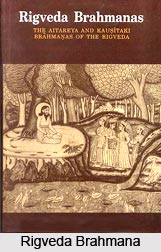 The Brahmanas in the Vedas form an essential part of the Vedic texts. They exist in the form of a commentary on the particular Vedic text and deal with the various aspects of prayer and sacrificed in minute detail. Every Veda has its own Brahmana attached to it. These are discussed below.
The Brahmanas in the Vedas form an essential part of the Vedic texts. They exist in the form of a commentary on the particular Vedic text and deal with the various aspects of prayer and sacrificed in minute detail. Every Veda has its own Brahmana attached to it. These are discussed below.
Rig Veda Brahmanas
To the Rig Veda belongs the Aitareya Brahmana. It consists of forty Adhyayas or "lessons," which are divided into eight Panchakas or "fifths." Tradition names Mahida Aitareya as the author of the work, though it is possible that in reality he was only the compiler or editor of it. This Brahmana deals chiefly with the Soma-sacrifice, besides the fire-sacrifice (Agnihotra) and the feast of the consecration of a king (Rajasuya). It is supposed that the last ten sections are of later origin.
In the closest relationship with this Brahmana is the Kausitaki or Brahmana, also belonging to the Rig Veda, and consisting of thirty Adhyayas or "lessons." The first six Adhyayas deal with the food-sacrifice (fire-laying, fire-sacrifice, new and full moon sacrifices and the sacrifices of the seasons), while Adhyayas VII to XXX deal with the Soma-sacrifice fairly agreeing with the Aitareya Brahmana. The Kausitaki Brahmana is later than the Aitareya Brahmana. However, while the latter is not the work of one hand and of one period, the Kausitaki Brahmana is a uniform work.
Sama Veda Brahmanas
To the Sama Veda belongs the Tandya Maha Brahmana, also called Panchavinisa, i.e. "Brahmana consisting of twenty-five books." This is one of the oldest Brahmanas and contains some important old legends. Of special interest are the Vratyastomas, and the description of sacrificial ceremonies by means of which the Vratyas were received into the community by the Brahmans. The Sadvimsa Brahmana, i.e. "the twenty-sixth Brahmana," is only a completion of the Tandya which consists of twenty-five books. The last part of the Sadvimsa is the so-called "Adbhuta Brahmana," a Vedanga text on miracles and omens.` The Jaiminiya Brahmana of the Sama Veda is even older than the Tandya Maha Brahmana. This work is of special interest for the history both of religion and legend, but unfortunately the manuscript material is so fragmentary that it cannot be edited.
Yajur Veda Brahamanas
The Taittiriya Brahmana of the Black Yajur Veda is nothing but a continuation of the Taittiriya Samhita, for the Brahmanas were already included in the Samhitas of the Black Yajur Veda. The Taittiriya Brahmana, therefore contains only later additions to the Samhita. There is to be found here only a description of the Purusamedha, the symbolical "human sacrifice" and the fact that the sacrifice is missing in the Samhita is one of the many proofs that it is only a rather late production of the science of sacrifice.
To the white Yajur Veda belongs the Satapatha Brahmana, "the Brahmana of the Hundred Paths," so called because it consists of one hundred Adhyayas or "lessons." This is the best known, the most extensive, and doubtless, also on account of its contents the most important of all the Brahmanas. There are two recensions of this Brahmana, that of the Kanvai and that of the Madhyandinas.
In the latter the hundred Adhyayas are distributed among 23 Kandas or books. The first nine books are simply a continuous commentary on the first eighteen sections of the Vajasaneyi Samhita. They are decidedly older than the last five books. Probably also Books I to V are more closely connected. In them Yajnavalkya, who at the end of Book XIV is called the author of the whole Satapatha Brahmana, is often mentioned as the teacher whose authority is conclusive. On the other band, in Books VI to IX, which deal with the fire-altar building (Agnicayana), Yajnavalkya is not mentioned at all. Instead of him another teacher, Sandilya, is quoted as an authority, and the same Sandilya is also regarded as the proclaimer of the Agnirahasya, i.e. of the fire-altar mystery, which forms the contents of Book X. Books XI to XIV, besides appendices to the preceding books, also contain a few interesting sections on subjects which are otherwise not dealt with in the Brahmanas. At the close of this extensive work is the old and important Brhadaranyaka Upanishad.
The difference between the Brahmanas which belong to the separate Vedas lies chiefly in the fact that the Brahmana of the Rig Veda, in the presentation of the ritual, emphasize that which is of importance to the Hotar priest, who has to recite the verses and hymns of the Rig Veda, while the Brahmanas of the Sama Veda are chiefly concerned with the duties of the Udgatar, and those of the Yajur Veda with the sacrificial acts to be performed by the Adhvaryu.
In the essentials of their contents the Brahmanas all agree fairly well with one another. In the main the same subjects are always deal with and all these works bear the same stamp.



















